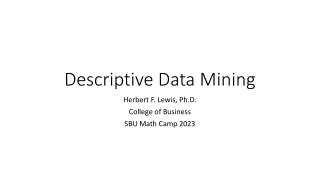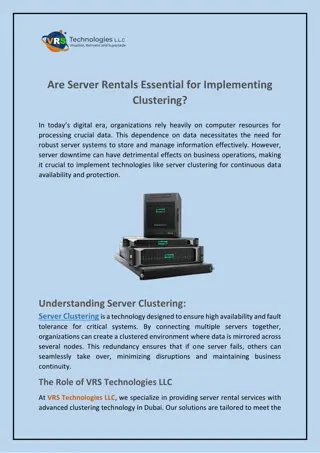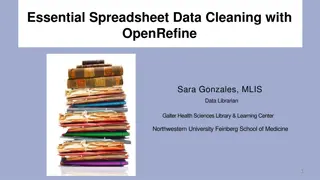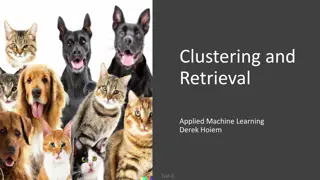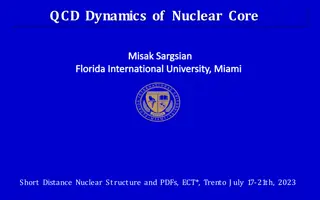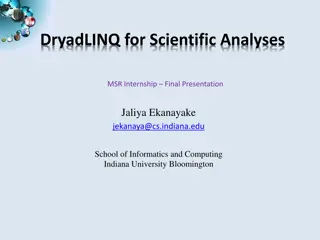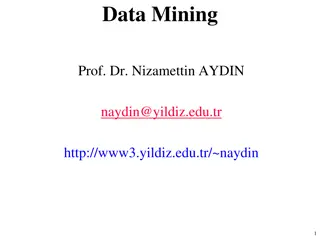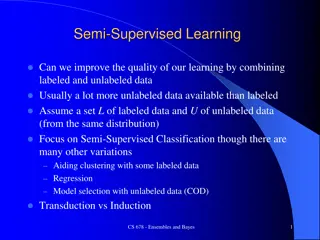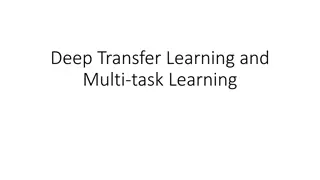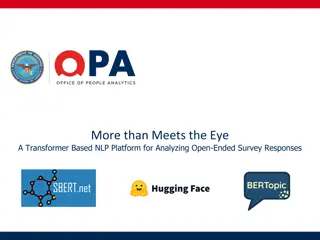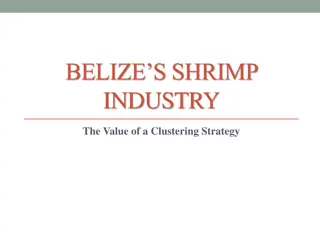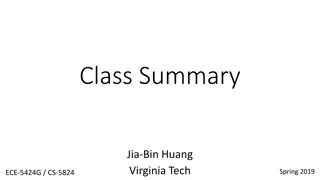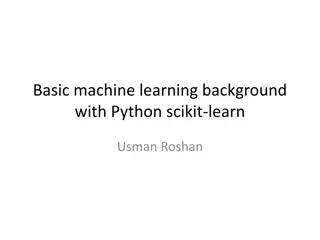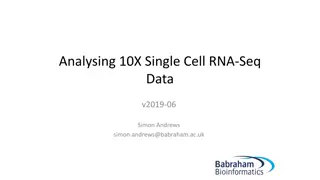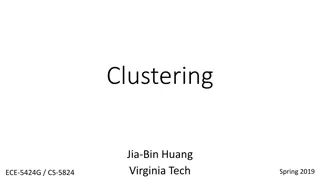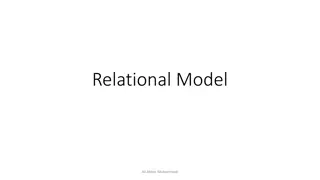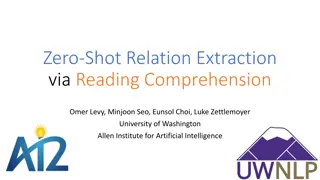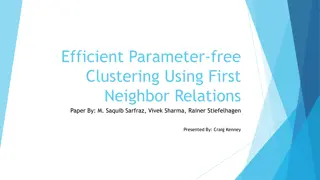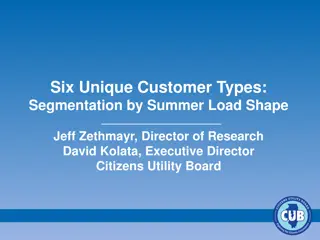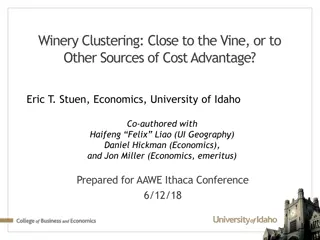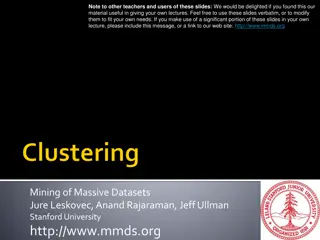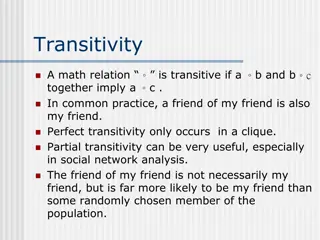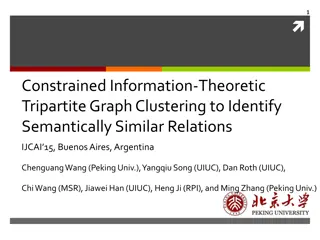AM-DisCNTDisCNT: Angular Multi-hop Distance Circular Network Transmission
An in-depth exploration of wireless sensor networks, applications, design challenges, and factors. Discusses the Low Energy Adaptive Clustering Hierarchy protocol. Includes real-world examples and informative visuals.
2 views • 36 slides
Descriptive Data Mining
Descriptive data mining analyzes historical data to find patterns, relationships, and anomalies, aiding in decision-making. Unsupervised learning and examples of techniques like clustering are explored, showcasing the power of data analysis in business.
1 views • 49 slides
Understanding Neural Networks: Models and Approaches in AI
Neural networks play a crucial role in AI with rule-based and machine learning approaches. Rule-based learning involves feeding data and rules to the model for predictions, while machine learning allows the machine to design algorithms based on input data and answers. Common AI models include Regres
9 views • 17 slides
ACEA TF-ACSI Work on Exterior Acoustic Signaling Report
The report details the work of ACEA Task Force Acoustic Signaling in harmonizing requirements, defining characteristics, and creating a framework for exterior acoustic signals. It encompasses reviewing regulations, clustering acoustic signaling functions, and prioritizing management. The objective i
5 views • 9 slides
Understanding Inference in Indian Philosophy
In Indian philosophy, inference is considered one of the six ways to attain true knowledge. It involves three constituents: Hetu (middle term), Sadhya (major term), and Paksha (minor term). The steps of inference include apprehension of the middle term, recollection of the relation between middle an
11 views • 8 slides
Are Server Rentals Essential for Implementing Clustering?
Discover why renting servers is important for clustering with VRS Technologies LLC's helpful PDF. Learn how to make your IT setup better. For Server Rental Dubai solutions, Contact us at 0555182748.
13 views • 2 slides
Essential Spreadsheet Data Cleaning with OpenRefine
OpenRefine is an open-source tool developed by Google for data cleaning without coding knowledge. It runs securely on your local browser and offers essential features like splitting rows, facet types, clustering, removing duplicates, number functions, and more. You can download OpenRefine, access cl
0 views • 28 slides
Understanding Clustering Algorithms: K-means and Hierarchical Clustering
Explore the concepts of clustering and retrieval in machine learning, focusing on K-means and Hierarchical Clustering algorithms. Learn how clustering assigns labels to data points based on similarities, facilitates data organization without labels, and enables trend discovery and predictions throug
0 views • 48 slides
New Features in Progress OpenEdge BPM 11.x
Progress OpenEdge BPM 11.x extends OpenEdge to a comprehensive platform for developing and deploying transaction-oriented and process-centric applications. It offers benefits like workflow automation, visibility into processes, model-driven development, and easy integration with external systems. Th
0 views • 13 slides
Insights into Nuclear Core Dynamics and Structure
Exploring the dynamics of nuclear cores, this research delves into the intricacies of probing the NN repulsive core, modern NN potentials, and field theories of nucleons and mesons. The study encompasses the isospin dependence, non-nucleonic components, hidden color, and gluons within the nucleus, s
1 views • 63 slides
Evaluation of DryadLINQ for Scientific Analyses
DryadLINQ was evaluated for scientific analyses in the context of developing and comparing various scientific applications with similar MapReduce implementations. The study aimed to assess the usability of DryadLINQ, create scientific applications utilizing it, and analyze their performance against
0 views • 20 slides
Understanding Similarity and Dissimilarity Measures in Data Mining
Similarity and dissimilarity measures play a crucial role in various data mining techniques like clustering, nearest neighbor classification, and anomaly detection. These measures help quantify how alike or different data objects are, facilitating efficient data analysis and decision-making processe
0 views • 51 slides
Bioinformatics for Genomics Lecture Series 2022 Overview
Delve into the Genetics and Genome Evolution (GGE) Bioinformatics for Genomics Lecture Series 2022 presented by Sven Bergmann. Explore topics like RNA-seq, differential expression analysis, clustering, gene expression data analysis, epigenetic data analysis, integrative analysis, CHIP-seq, HiC data,
0 views • 36 slides
Understanding Frequent Patterns and Association Rules in Data Mining
Frequent pattern mining involves identifying patterns that occur frequently in a dataset, such as itemsets and sequential patterns. These patterns play a crucial role in extracting associations, correlations, and insights from data, aiding decision-making processes like market basket analysis. Minin
1 views • 95 slides
Understanding Semi-Supervised Learning: Combining Labeled and Unlabeled Data
In semi-supervised learning, we aim to enhance learning quality by leveraging both labeled and unlabeled data, considering the abundance of unlabeled data. This approach, particularly focused on semi-supervised classification, involves making model assumptions such as data clustering, distribution r
0 views • 17 slides
Understanding Deep Transfer Learning and Multi-task Learning
Deep Transfer Learning and Multi-task Learning involve transferring knowledge from a source domain to a target domain, benefiting tasks such as image classification, sentiment analysis, and time series prediction. Taxonomies of Transfer Learning categorize approaches like model fine-tuning, multi-ta
0 views • 26 slides
Transforming NLP for Defense Personnel Analytics: ADVANA Cloud-Based Platform
Defense Personnel Analytics Center (DPAC) is enhancing their NLP capabilities by implementing a transformer-based platform on the Department of Defense's cloud system ADVANA. The platform focuses on topic modeling and sentiment analysis of open-ended survey responses from various DoD populations. Le
0 views • 13 slides
Advertising and Promotional Techniques in Public Relation Management
Explore the world of advertising and promotional techniques in Public Relation Management with topics such as positioning the organization, managing rumors, and maintaining a positive brand reputation. Learn strategies to improve analytical skills, conduct communication audits, and formulate public
0 views • 17 slides
Enhancing Belize's Shrimp Industry Through Clustering Strategies
Belize's shrimp industry is a vital part of its economy, facing challenges in scaling production for exports. Emphasizing quality and identifying competitive advantages are key, along with capitalizing on niche markets and seeking certification. Clustering strategies can help firms collaborate, shar
0 views • 6 slides
Understanding Myhill-Nerode Theorem in Automata Theory
Myhill-Nerode theorem states that three statements are equivalent regarding the properties of a regular language: 1) L is the union of some equivalence classes of a right-invariant equivalence relation of finite index, 2) Equivalence relation RL is defined in a specific way, and 3) RL has finite ind
1 views • 20 slides
Horizon Results Booster - Maximizing Impact for Research & Innovation Projects
The Horizon Results Booster, a service offered by the European Commission, aims to boost the impact of Research & Innovation projects by helping beneficiaries better disseminate and valorize their results, increase exploitation potential, improve access to the market, and implement effective dissemi
0 views • 4 slides
Geography Practice Exam Round 1 Questions
Practice your AP Human Geography knowledge with these multiple-choice questions covering topics such as demographic indicators, cultural diffusion, population growth, cultural landscapes, and urban land use patterns. Test your understanding of concepts like fertility rates, diffusion types, populati
0 views • 106 slides
Machine Learning Algorithms and Models Overview
This class summary covers topics such as supervised learning, unsupervised learning, classification, clustering, regression, k-NN models, linear regression, Naive Bayes, logistic regression, and SVM formulations. The content provides insights into key concepts, algorithms, cost functions, learning a
0 views • 39 slides
Understanding Basic Machine Learning with Python using scikit-learn
Python is an object-oriented programming language essential for data science. Data science involves reasoning and decision-making from data, including machine learning, statistics, algorithms, and big data. The scikit-learn toolkit is a popular choice for machine learning tasks in Python, offering t
0 views • 34 slides
Equivalence Relations and Partition Induced Relations
The concept of equivalence relations and partition-induced relations on sets are explored. Equivalence relations satisfy reflexivity, symmetry, and transitivity, making them important in various mathematical contexts. The relation induced by a partition of a set is shown to be an equivalence relatio
0 views • 24 slides
Understanding 10X Single-Cell RNA-Seq Data Analysis
Explore the intricacies of analyzing 10X Single-Cell RNA-Seq data, from how the technology works to using tools like CellRanger, Loupe Cell Browser, and Seurat in R. Learn about the process of generating barcode counts, mapping, filtering, quality control, and quantitation of libraries. Dive into di
0 views • 34 slides
Overview of Unsupervised Learning in Machine Learning
This presentation covers various topics in unsupervised learning, including clustering, expectation maximization, Gaussian mixture models, dimensionality reduction, anomaly detection, and recommender systems. It also delves into advanced supervised learning techniques, ensemble methods, structured p
1 views • 37 slides
Understanding the Key Concepts of Relational Databases
Introduction to the fundamental concepts of relational databases including the relational model proposed by Edgar F. Codd, relation schemes, relation instances, keys for a relation, and more. Discover the significance of keys, candidate keys, superkeys, and primary keys in database design.
0 views • 27 slides
Spatial Relation Switching Requirements in 3GPP NR RAN Plenary Meeting
The document discusses various spatial relation switching requirements for uplink scenarios in the 3GPP NR RAN Plenary Meeting. It covers agreement points related to UL SRS, PUCCH, P-SRS, and DL-RS, defining delay requirements and known conditions for spatial relation switching. The agreements provi
0 views • 11 slides
Zero-Shot Relation Extraction via Reading Comprehension
In this study by Omer Levy, Minjoon Seo, Eunsol Choi, and Luke Zettlemoyer from the University of Washington and Allen Institute for Artificial Intelligence, a model is presented for zero-shot relation extraction via reading comprehension. The model can extract relations between entities without dir
0 views • 29 slides
Text Analytics and Machine Learning System Overview
The course covers a range of topics including clustering, text summarization, named entity recognition, sentiment analysis, and recommender systems. The system architecture involves Kibana logs, user recommendations, storage, preprocessing, and various modules for processing text data. The clusterin
0 views • 54 slides
Efficient Parameter-free Clustering Using First Neighbor Relations
Clustering is a fundamental pre-Deep Learning Machine Learning method for grouping similar data points. This paper introduces an innovative parameter-free clustering algorithm that eliminates the need for human-assigned parameters, such as the target number of clusters (K). By leveraging first neigh
0 views • 22 slides
Understanding Set Operations and Relation Algebra
Delve into the intriguing world of set operations and relation algebra, exploring concepts such as set intersection, natural join, and generalized projection. Unravel the complexities of database queries and examples from the banking sector to enhance your knowledge in this domain.
0 views • 28 slides
Customer Segmentation and Usage Patterns Analysis
This research delves into segmenting customers based on summer load shapes and matching usage patterns to demographic profiles using census data. It analyzes daily interval volume readings for residential customers, identifies load shape clusters, and explores their distribution across different are
0 views • 15 slides
Machine Learning Techniques: K-Nearest Neighbour, K-fold Cross Validation, and K-Means Clustering
This lecture covers important machine learning techniques such as K-Nearest Neighbour, K-fold Cross Validation, and K-Means Clustering. It delves into the concepts of Nearest Neighbour method, distance measures, similarity measures, dataset classification using the Iris dataset, and practical applic
0 views • 14 slides
Understanding Winery Clustering in Washington State: Factors and Implications
Explore the phenomenon of winery clustering in Washington State, examining factors such as natural advantages, collective reputation, and demand-side drivers. Discover why wineries in the region tend to locate close to each other and the impact on cost advantage and industry dynamics.
0 views • 18 slides
Understanding Data Structures in High-Dimensional Space
Explore the concept of clustering data points in high-dimensional spaces with distance measures like Euclidean, Cosine, Jaccard, and edit distance. Discover the challenges of clustering in dimensions beyond 2 and the importance of similarity in grouping objects. Dive into applications such as catalo
0 views • 55 slides
Understanding K-means Clustering for Image Segmentation
Dive into the world of K-means clustering for pixel-wise image segmentation in the RGB color space. Learn the steps involved, from making copies of the original image to initializing cluster centers and finding the closest cluster for each pixel based on color distances. Explore different seeding me
0 views • 21 slides
Understanding Transitivity and Clustering Coefficient in Social Networks
Transitivity in math relations signifies a chain of connectedness where the friend of a friend might likely be one's friend, particularly in social network analysis. The clustering coefficient measures the likelihood of interconnected nodes and their relationships in a network, highlighting the stru
0 views • 8 slides
Semantically Similar Relation Clustering with Tripartite Graph
This research discusses a Constrained Information-Theoretic Tripartite Graph Clustering approach to identify semantically similar relations. Utilizing must-link and cannot-link constraints, the model clusters relations for applications in knowledge base completion, information extraction, and knowle
0 views • 14 slides

